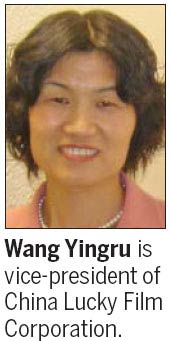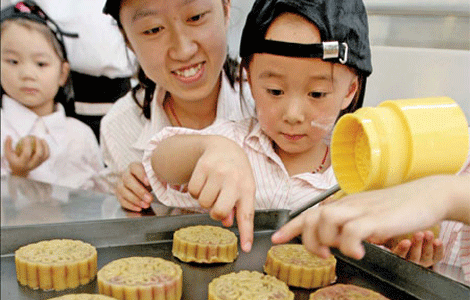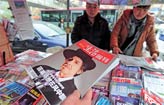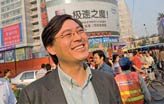Lucky's lucky streak
Updated: 2011-09-16 10:48
By Zhao Yanrong (China Daily)
Baoding film company back on the growth path with new business focus
|
 Lucky Film's solar back sheet product line in Baoding. New business contributed about 42 percent to its profit last year. Provided to China Daily |
Though much of Baoding's success comes from the innumerable solar panel companies, there are other companies that have managed to buck the industrial downturn and carve their own niche.
Playing second fiddle is something that most companies would detest especially if your partner has been a trailblazer for several decades and a name synonymous with the industry.
But Wang Yingru, vice-president of the Baoding-based China Lucky Film Corporation set up in 1958, feels that while "it is sad to see old stars fading, it is also the time for companies to change tack and embrace new growth opportunities that suit market situations".
Lucky Film's fortunes have over the years been a series of ups and downs, but the company still finds itself in a much better shape than its erstwhile partner and industry giant Eastman Kodak Company.
 |
"Kodak had been our role model for several decades," Wang says, adding that people within the industry could hardly imagine its decline.
But Lucky has been luckier.
During the first six months of this year Lucky Film reported a 10.39 percent rise in operating income to 393 million yuan (45 million euros) over the same period of last year. Net profit during the same period was 4.674 million yuan, compared to a net loss of 600,000 yuan in 2010.
According to Wang, what makes the company's numbers stand out is that it has been achieved against a backdrop of rising raw material costs, falling product prices and intense competition.
"Most of the losses came from our traditional photo film business. To mitigate the effects we embarked on a transformation path that focused on market expansion, quality stabilization and cost reduction," she says.
"When people suddenly stopped using our films, we did not know what to do. But we realized that our future focus would have to be market and technology driven."
Lucky Films decided that it was time to embrace the digital route to success.
As a first step Lucky Film decided to make its photographic paper suitable for direct digital output, thereby making the dark room technology for developing films obsolete.
But that move did not prove to be transformational enough on the balance sheet as it faced stiff competition from bigger players such as Sony and Canon. Undeterred by the setback, Wang says, the company decided to change tack again.
"Digital products get updated often, and some digital companies have superior technological advantages in the business. Even if we try to maintain our market share, the profit margin will not be up to our expectations," Wang says.
According to Wang, Lucky Film decided to capitalize on its edge in making fine chemicals such as film materials, coating materials and image recording materials.
"Our strategy was to focus on our core competencies rather than grow the traditional markets. It helped us to get more opportunities," she says.
At the same time the company also modeled itself on the likes of its former partner Kodak's archrival Fujifilm for future growth. Fujifilm's plan to enter the cosmetics business in 2006 was one of those business-changing decisions. But for the moment Lucky Film is betting big on the new energy industry represented by solar energy.
Lucky Film started research and development work on solar back sheet film technologies in 2006, and started making solar back sheet films in May 2008.
The back sheet for the solar energy cells was launched in the market last year and is essentially used to cover the solar photovoltaic panels and protect the silicon solar cells. The back sheets help the solar cells to work for over 25 years in proper condition.
"Unlike films and photographic paper, the new business imposes stricter requirements on our products and services," Wang says.
Being an integral part of the solar energy panels, any problem with the back sheet film could end up in damage to the cells, she says. To mitigate the problems the company is looking to constantly introduce new technology and improve product quality.
"This is a new industry which we are still exploring through practice. But with 50 years of experience in photosensitive material technologies, we definitely have an edge over others," she says.
"When a solar cell company needs a new back sheet film, it is not easy to get one from the open market. Very often most of these queries end up with us," she says.
To some extent it is the renewed focus on new business that has pulled the company out of the woods. Wang says the Baoding-based company's new business accounted for about 42 percent of the profit last year, while in revenue terms it was around 19 percent.
"The current business indicators are the best in the last 10 years, considering that the traditional film business accounted for just 1 percent of the total sales," the company says in its annual report.
At the same time, the company is also planning to strengthen its value chain by acquiring companies that are into film material technologies.
"We hope we can be among the top companies in the membrane industry in China by 2015," Wang says.
E-paper

Way over the moon
High inflation rockets mooncake prices out of orbit for mid-autumn festival
From death matches to child's play
Tomb raiders remain a menace
Kicking for joy
Specials

Singing success
Western musicians bring much-needed impetus to live performance industry

Salary bonanza for bosses
Top boss gets 8.78 million euros a year, far more than the State enterprise CEO with highest pay

Kicking for joy
Swedish college student represents China in Taekwondo championships
